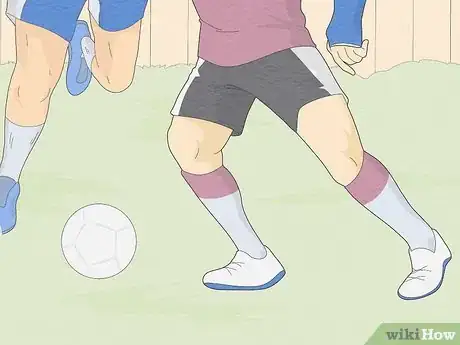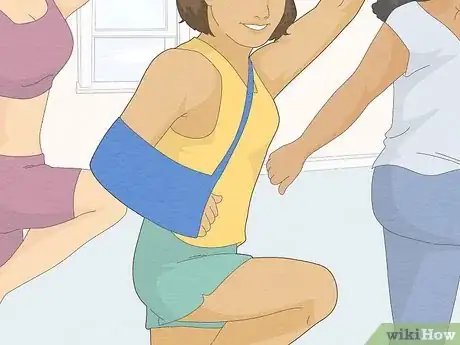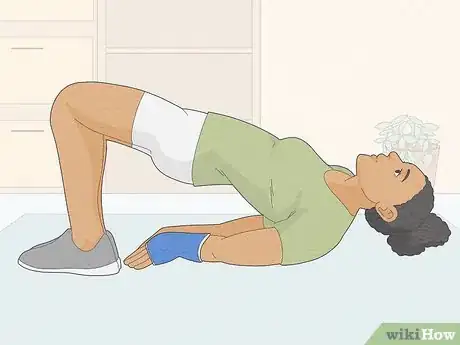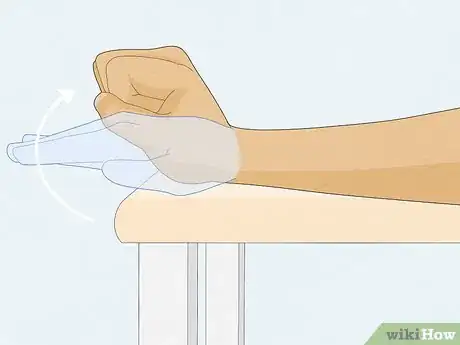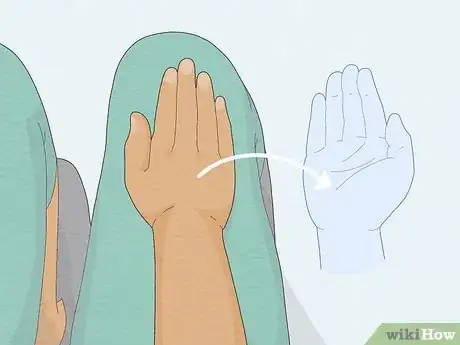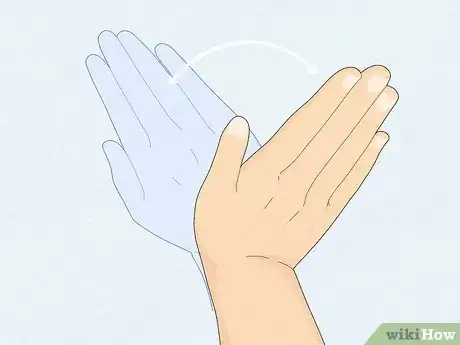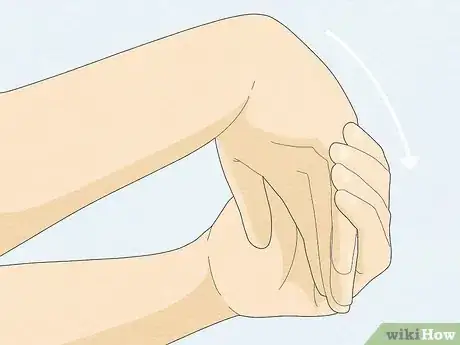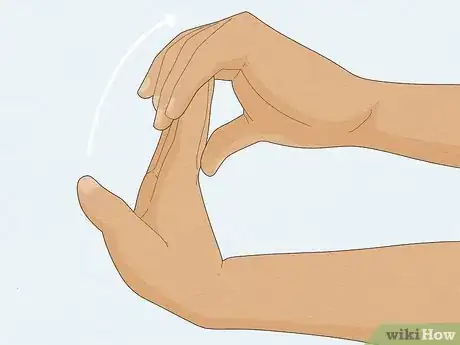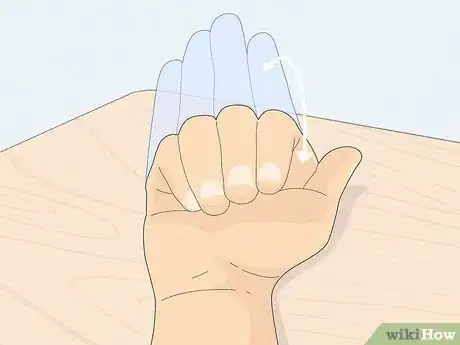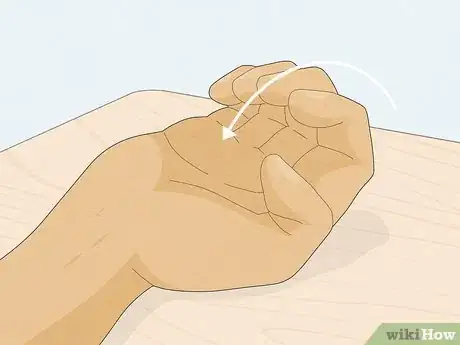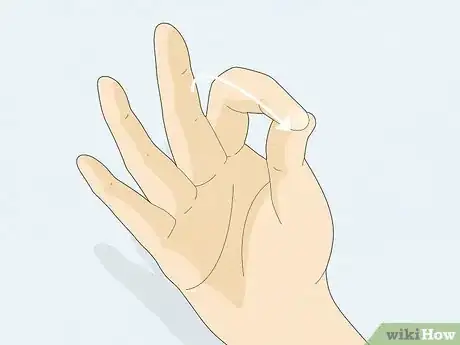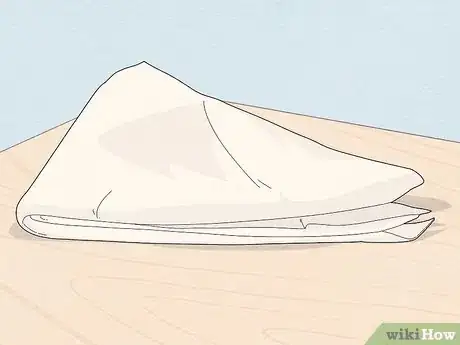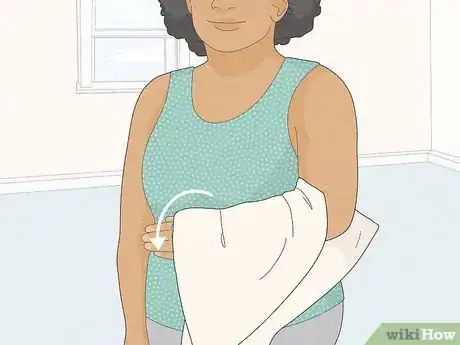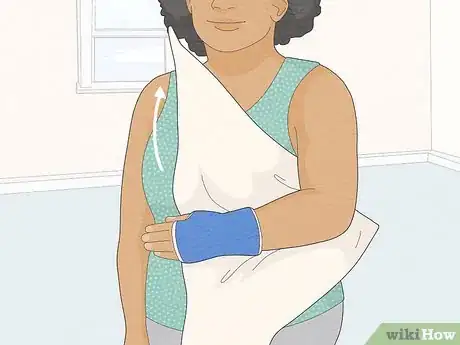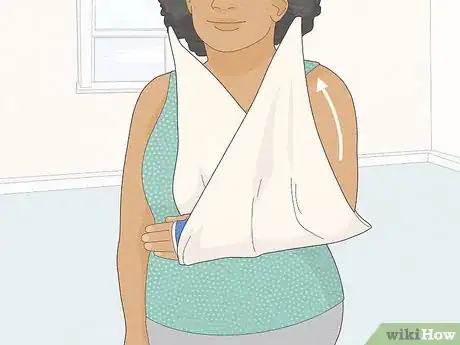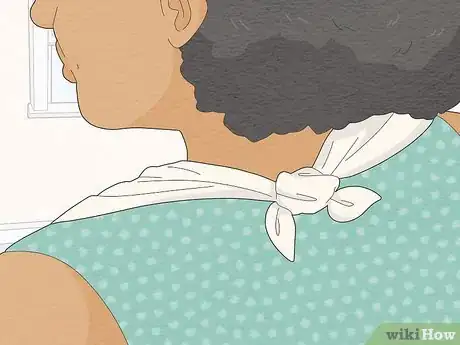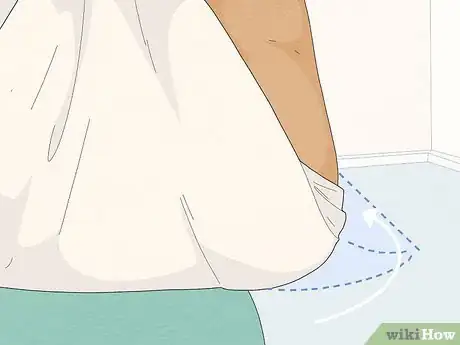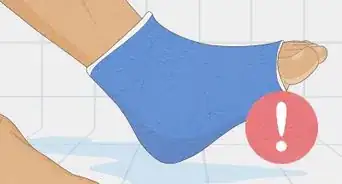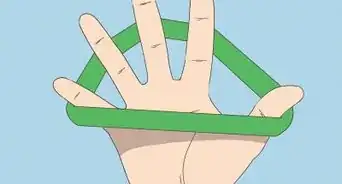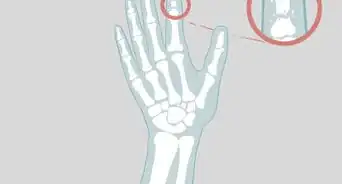This article was medically reviewed by Jonas DeMuro, MD. Dr. DeMuro is a board certified Pediatric Critical Care Surgeon in New York. He received his MD from Stony Brook University School of Medicine in 1996. He completed his fellowship in Surgical Critical Care at North Shore-Long Island Jewish Health System and was a previous American College of Surgeons (ACS) Fellow.
There are 12 references cited in this article, which can be found at the bottom of the page.
This article has been viewed 135,138 times.
Broken bones can be difficult to deal with, especially when they interfere with your regular exercise program. However, if you find yourself with a broken wrist, you do not need to put exercising on the back burner until your wrist is healed.
Steps
Doing Aerobic Exercises
-
1Go for a walk or a jog. Walking and jogging have many health benefits and can be easily done with a broken wrist. Depending on your exercise goal, you can adjust your distance and intensity to make the exercise harder.[1]
- Be sure to keep your wrist in a neutral position while walking.
- Slightly tighten your stomach muscles and keep your back straight to engage your core muscles.
- Regular walking and jogging have many health benefits, including strengthening your bones and muscles, helping to maintain healthy weight, and improving coordination and balance.
-
2Play a game of tennis. Tennis is one of those sports you can do one-handed. It also gives nice variability to walking and jogging. As with walking, keep your broken wrist in a sling in a neutral position at all times while using your uninjured hand for playing.[2]
- Besides burning fat and improving your cardiovascular fitness, tennis also helps build muscles in your legs and especially in the arm and shoulder you are playing with.
- Jumping and running will also help improve bone density and bone strength.
Advertisement -
3Play soccer. Soccer involves a lot of running and is a great way to improve your cardiovascular fitness, while having fun with your friends. Secure your broken wrist in a sling and get your feet kicking.[3]
-
4Take a dance or aerobics class. Besides offering the same health benefits as the exercises above, dancing/aerobics does it with style. And if you get tired of one type of class, switch it up and try the different choices available, such as jazzercise, Zumba or step aerobic class.[4]
- Be sure to have your wrist positioned neutrally and avoid all moves that engage it (perform these with one hand only).
-
5Go hiking and enjoy nature. Hiking is an excellent workout that can be very strenuous depending on the route you take. Climb up those hills carefully, as you do not want to fall and further injure the wrist. Walking uphill will increase your cardiac output and burn some extra calories. Don’t forget to enjoy the scenery. Besides improving your fitness, this can be very relaxing and stress-relieving as well.[5]
Doing Muscle Building Exercises
-
1Strengthen the muscles in your legs. You can engage the different muscles in your body without using or disturbing your broken wrist. To strengthen the muscles in your legs, do simple squats and lunges and keep your arms neutral on the sides of your body.
- Do squats by standing in a wide stance, facing forward and keeping your back straight. While pushing your hips and butt back and knees slightly forward, squat down until your thighs are slightly past parallel to the floor. Remember to keep feet and knees pointed in the same direction. Your knees should never extend beyond your toes. Straighten and repeat.[6]
- Do alternate lunges by stepping forward with one leg. Then, lower your body by flexing the hip and knee of the front leg until your rear knee almost touches the floor. Return up and lunge forward using the opposite leg.[7]
-
2Strengthen the muscles in your back. Although many back exercises require the use of dumbbells and weights, you can do bodyweight exercises that can be done with a broken wrist.
- Do bridges by laying on the floor on your back with your arms resting next to your body. Keep your feet flat on the floor and knees bent. Slowly raise your bottom up until your knees and shoulders form a straight line. Remain in this position for 10 – 15 seconds, then lower and repeat.[8]
- The dart is another exercise you can do with a broken wrist. Lie down on your stomach and keep your arms extended toward your feet next to your body. Lift your upper body and legs off the floor at the same time using your back muscles. Count to 10 – 15, relax, and repeat.[9]
-
3Strengthen your abdominal muscles. Abs are easily worked with a broken wrist when you choose exercises such as twists and crunches.
- To begin with crunches, lie flat on the floor with your lower legs on a bench. Keep your arm with your broken wrist on your side at all times, and bring your other arm up behind your neck. Raise your upper body from the mat by contracting your abdominal muscles. Raise your torso as high as you can while keeping your lower back on the floor. Bring your torso back down, and repeat.[10]
- With twists, both your arms are extended out to each side while you lie on your back. Slightly bend your knees and raise your legs off the floor with your knees bent on a 90 degree angle. Next, lower your legs on one side until the side of your thigh hits the floor. Return to the middle and go to the other side. Repeat from side to side.[11]
Doing Physiotherapy for Broken Wrist
-
1Do wrist flexion and extension exercises. Wrist flexion and extension are one of several exercises that are important to get your wrist back to the condition it was prior to the injury. However, do not start any of these exercises until your doctor tells you that you can. Start slowly and stop of if you experience any pain.
- Place your forearm with the bad wrist on the table.
- Have your hand face palm down and extend your wrist and hand past the table edge.
- Move your hand up by bending your wrist and close your hand into a fist.
- Next, lower the hand and relax your fingers.
- Each position should be held for six seconds.
-
2Do hand flips. This exercise should only be done after your doctor or physiotherapist gives you the go ahead. Do the exercise eight to 12 times but only if it is pain free.
- Sit down and place the affected wrist and forearm on your thigh with your palm facing down.
- Flip your hand, so that your hand is now facing palm up and resting on the thigh.
- Repeat flips to alternate between palm down and palm up.
-
3Try radial and ulnar deviation exercises. Wrist radial and ulnar deviation is the motion of moving your wrist from side to side. Start slowly and if no pain is present, repeat 8-12 times.
- Hold the hand with the broken wrist in front of you, palm facing down.
- Bend your wrist slowly as far as possible, from one side to the other.
- Each position should be held for six seconds.
-
4Stretch your wrist extensors. Wrist extensor stretch can be an effective exercise to get your wrist back in shape. When no pain is present, repeat this move two to four times.
- Extend your arm with the broken wrist.
- Point the fingers toward the ground.
- Use your other hand and bend your wrist until you feel a stretch that is mild to moderate in the forearm.
- Hold for 15 to 30 seconds.
-
5Stretch your wrist flexors. Wrist flexor stretch can be difficult with a broken wrist at first. Start slowly and do not overdo it if you feel pain.
- Extend your arm with the broken wrist in front of you, palm facing away from the body.
- Point your fingers toward the ceiling by bending your wrist back.
- Use your other hand to bend the wrist gently toward you or press it against a wall.
- When you feel a stretch in the forearm, stop.
-
6Do intrinsic flexion. This is an exercise that will help to get your grip back after the injury.
- Rest your broken wrist on the table one side against the surface, holding your fingers straight.
- Bend your fingers toward you from the joint that connects your fingers to your palm but keep the fingers otherwise straight so that you form a 90 degree angle.
- Return to the starting position and repeat.
-
7Do MP extension exercise. This is another exercise to help get your grip back and ideally should be done eight to 12 times per session.
- With your palm up, have the good hand placed on a table.
- Take your injured hand and enfolded the fingers around the thumb of the hand that is good.
- Uncurl the joints slowly on the injured hand.
- Have only two of the top joints bent from your fingers so that your fingers look like a hook.
- Return to the position you started at and repeat.
-
8Do finger and thumb exercises. To get as much as possible out of these exercises, they need to be done as quickly as possible.[12]
- Use the thumb on your injured hand and touch the tip of every finger with it. Do this as quickly as you can.
- Have your injured hand face palm upward and bend your thumb to the little fingers base. Then, stretch it out as far as you can to the side.
Making a Sling for a Broken Wrist
-
1Get a large triangular bandage to make a sling with. When exercising with a broken wrist, it is recommended you use a sling to maintain the writs in a neutral position. Besides providing protection, the sling prevents the wrist from excess movement that could worsen the injury.[13]
-
2Take the triangular bandage and slide it under the injured arm. The tip of the bandage should stick out farther than your elbow.
-
3Pull the tip of the bandage. Do this gently so that the tip is pulled toward the shoulder opposite of the affected arm and around your neck.
-
4Pull the opposite side upward. Take the part that is hanging down and pull it over the injured arm. The tips should meet behind the neck.
-
5Ask someone to assist you in tying a knot. This step might be impossible for you do to on your own.
- Above the collarbone, have your assistant tie the ends to a knot.
-
6Adjust the sling. Ask your assistant to adjust the sling so that it supports the arm all the way to your little finger.
- Fit the sling around your elbow by twisting the tip with a safety pin or tucking it in.
Warnings
- Do not put pressure on your wrist without a doctor's approval.⧼thumbs_response⧽
References
- ↑ http://www.mayoclinic.org/healthy-lifestyle/fitness/in-depth/walking/art-20046261
- ↑ http://www.usta.com/Improve-Your-Game/Sport-Science/114688_Health_Benefits_of_Tennis_Why_Play_Tennis/
- ↑ http://www.sport-fitness-advisor.com/soccertraining.html
- ↑ http://www.aarp.org/health/fitness/info-2005/dance_to_health.html
- ↑ https://www.fitnessblender.com/blog/calories-burned-hiking-what-muscles-are-used-in-hiking
- ↑ http://www.exrx.net/WeightExercises/GluteusMaximus/BBSquat.html
- ↑ http://www.exrx.net/WeightExercises/GluteusMaximus/BBWalkingLunge.html
- ↑ http://www.whyiexercise.com/back-strengthening-exercises.html#gallery[pageGallery]/0/
- ↑ http://www.whyiexercise.com/back-strengthening-exercises.html#gallery[pageGallery]/0/
About This Article
To exercise with a broken wrist, go for a walk or a jog, which you can do safely as long as you keep your wrist in a neutral position. If you enjoy tennis, just make sure to use your uninjured hand for playing and keep you broken wrist in a sling in a neutral position. You can also go hiking or play soccer with a broken wrist, as long as you keep it in a sling or allow it to rest comfortably at your side. Alternatively, perform muscle building exercises like squats and lunges without disturbing your broken wrist at all. When it’s time to start exercising your injured wrist, work with a doctor or physical therapist to learn how to do wrist flexions and extensions, hand flips, and stretches. For more tips from our Medical co-author, including how to make a sling for your broken wrist, keep reading!


